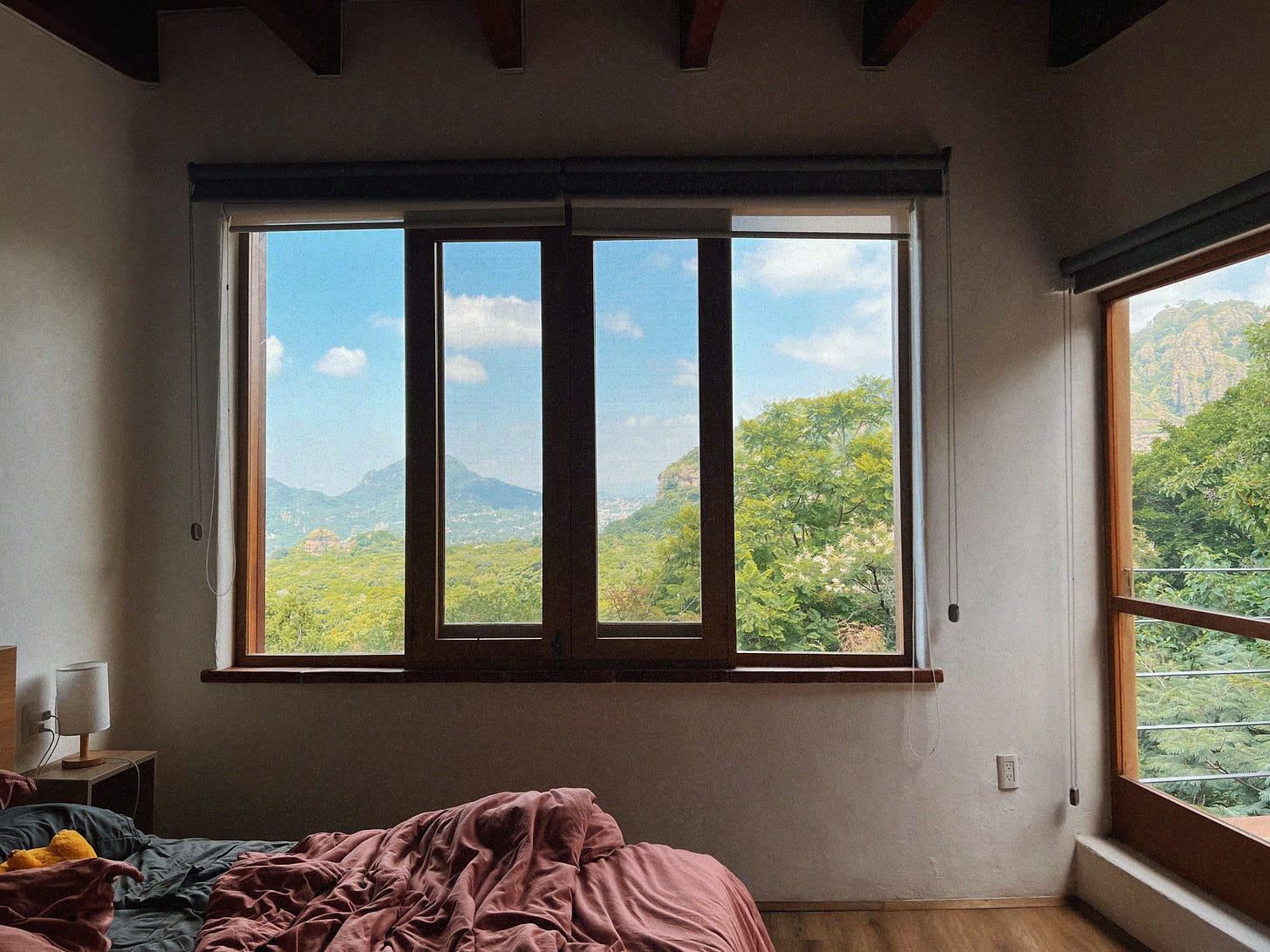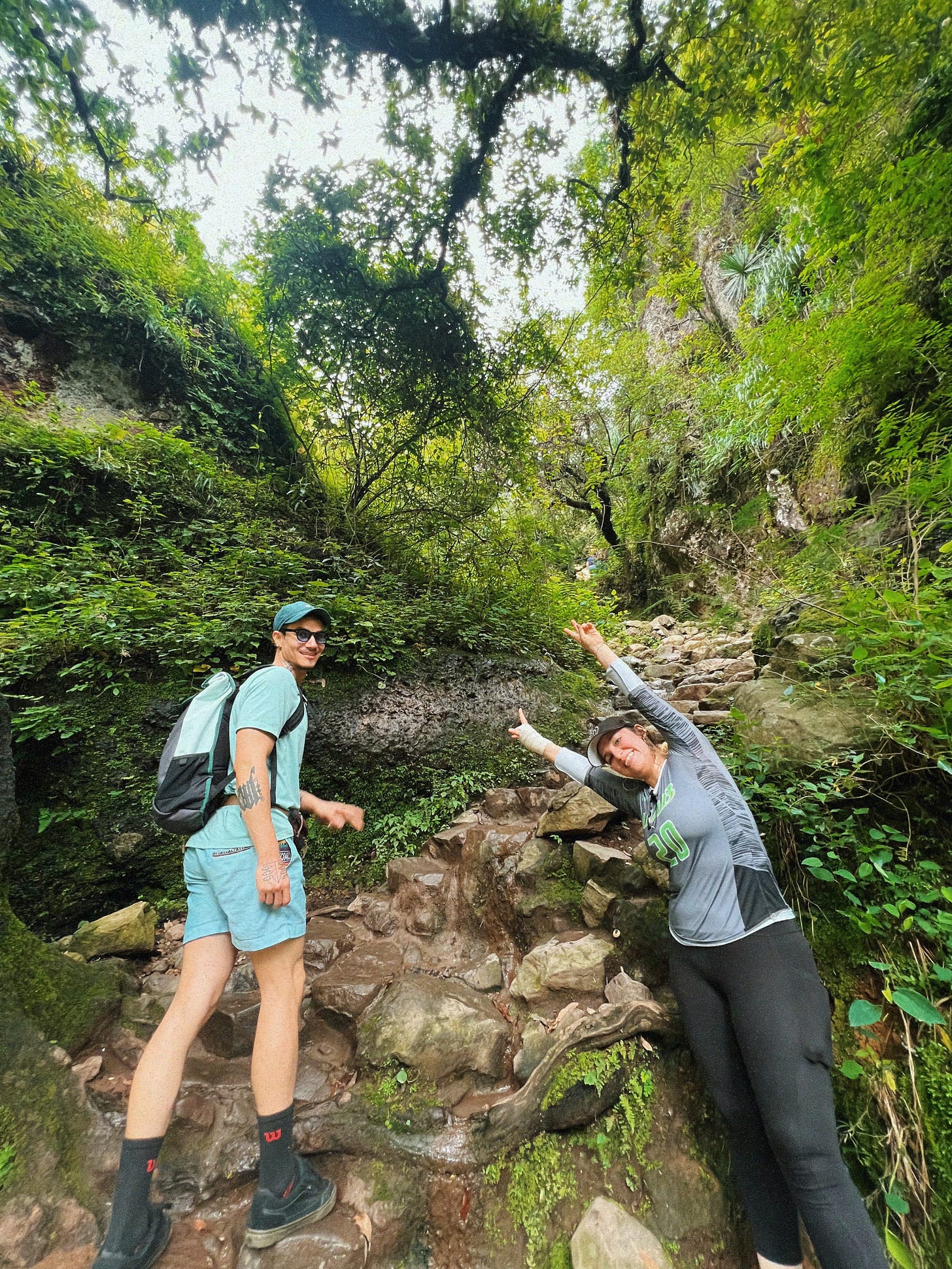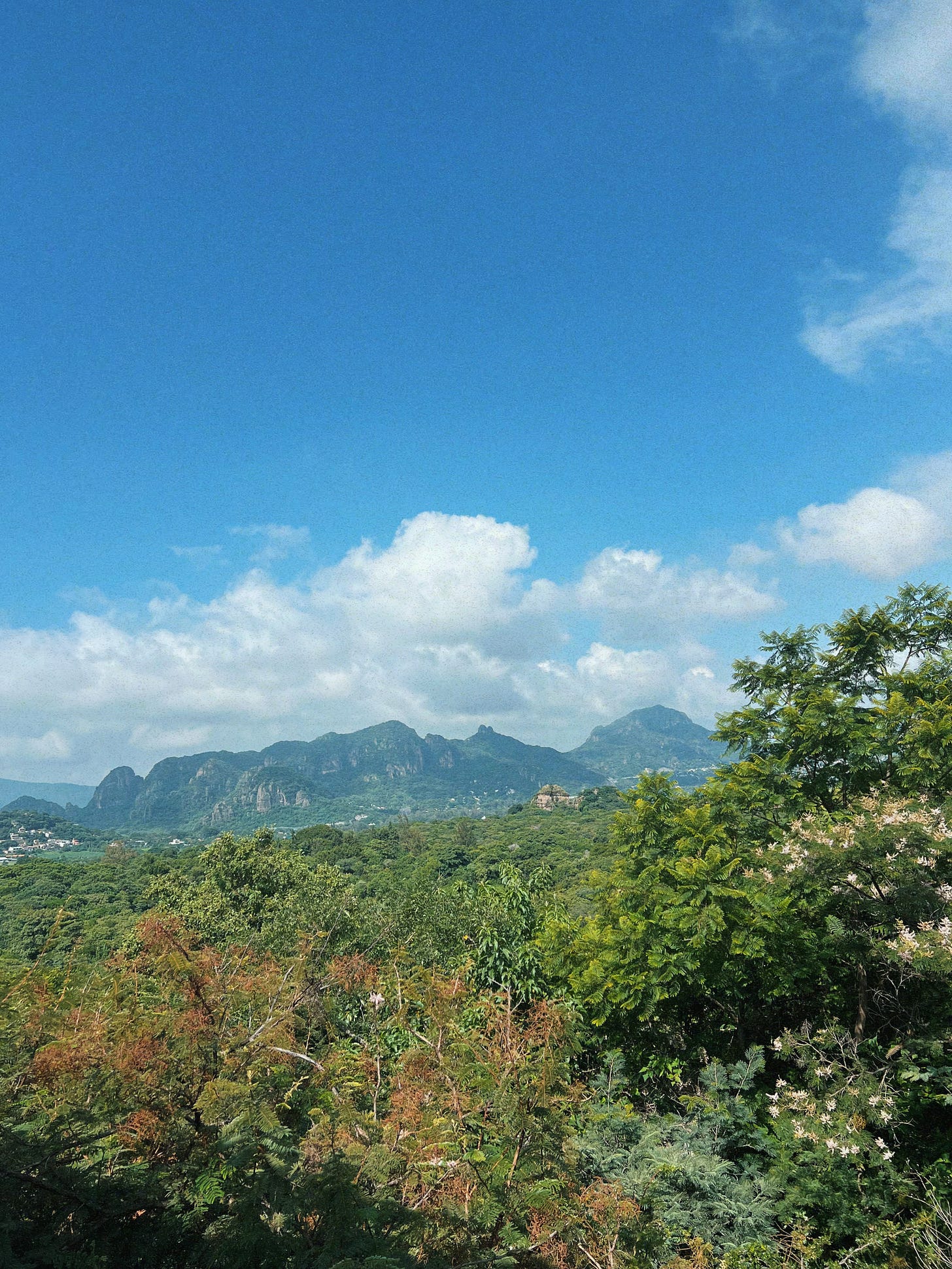Dear God, Thank You for Not Making Me Fresa
visiting tepoztlán ☼ microdosing on shrooms ☼ lessons from a man on the mountain ☼ the tone of the fresa
An hour outside of Mexico City, a magical town breathes between the mountains, ripe and overrun with plants. Tepoztlán is one of many “pueblo mágicos,” the official name of the government program that defines small towns around Mexico as hubs of cultural heritage, history, natural beauty, cuisine, and art. My partner Mijael, my friend Marisa and I took a bus to Tepoztlán to spend a weekend in the tropical refuge away from the city and its constant hum of cars, motorcycles and sirens. Our plan was simple: stay at a cabin tucked into shoulders of green, climb to the Tepozteco Pyramid (the infamous hike everyone finishes with micheladas) and microdose shrooms.
The first time I microdosed shrooms, I felt the belly of my younger self overtake my soul. A hunger for life and fascination for living awakened between my temples. I spent a weekend camping with two friends in upstate New York, frolicking around the woods, checking for ticks and channeling as much of the forest’s spirit as I could before we returned to the city. I remember jumping up and down on large boulders in a shallow creek, thinking that I could feel the earth bounce back at me, as if the ground was the skin of a living being. Everything was living, breathing and multiplying. I wrote half-finished thoughts in my phone like the phrases in our heads we think before we sleep, convinced that life’s answers were channeling through me like a beacon of light, that read:
the clouds are like us, living and breathing and…
we are all little children of the earth, like dwarves
knowing is a human obsession, nature knows more and we will never outdo it
As the sun began to retreat to the horizon, a rich and watery light stretched around the trees like the arms of a god, magnifying the colors of the forest and the creatures we shared it with. Hundreds of little bugs that I took for baby fireflies danced around me. I watched them as they perched on my arms, neck and face, speaking to them as if they were friends I had not seen in years. The next morning, I woke up with twenty seven mosquito bites.
Nowadays, I know better. Mijael, Marisa and I walked through the center of Tepoztlán towards Sierra de Tepoztlán with a backpack stocked with mosquito spray, dried mangos and water. The town, which crescendoes into crowds of drinking tourists from Mexico City and its neighboring places in the afternoon, brimmed with a tame quiet. I often think about Mijael, Marisa and I as three characters in a cartoon, like the Three Musketeers, walking and smiling and yawning, cooking and eating and oo-ing and ah-ing. In a city full of close to nine million people, it is nice and necessary to be able to spend time with people who make you feel at home.
Clouds of fog and premature rain lingered around the mountain, sheltering us and several other hikers from the sun. As if encouraged by the soft humidity of the air, everyone was silent on the way up, breathing slow and sweating a lot. The climate reminded me of Hawaii in a good season, temperate and humid, relief brought on by a cool damp. With the initial incline, we joked that we did not have to finish the hike if we did not want to, but as we continued up, the process of finishing seemed more and more manageable.
A man that appeared to be around the age of seventy or higher stood out from the rest of the hikers. He approached the climb like a gardener approaches the earth, paying attention to the soil and where he stepped, assessing each move for several seconds before placing one foot in front of the other. His approach contrasted that of others who rushed forward, cutting in between and around other hikers as if they had to be back at the bottom of the mountain at a precise time.
The hike has an elevation gain of 1,200 feet and slippery terrain. Many of the rocks have been polished by the rain and act like the bottom of a bowling alley if your shoes lack the proper grip. By the end of the hike, we saw several people fall. We grimaced at a few who paraded forward in impatience and smiled at those who dreamt aloud of the micheladas they would drink at the bottom. Seeing the older man made me think about how addicted to speed we are as a society (which I’ve written about before), how dangerous that is and how much smarter, safer and successful a slow, consistent approach to life can be.
All three of us recognized the strength and intelligence that the older man exhibited compared to his rushed counterparts. Marisa wondered aloud if he was put there by the gods, a spiritual reminder for us, designed for our trip. We passed him, as did almost everyone else, and made several stops along the way for water, air, mangos and chocolate-covered bananas that were being sold like beers at a baseball game. As we approached the top of the mountain, we saw the man again. He arrived at the summit at the same time as everyone else, as if the story of the tortoise and the heir was being played out in front of us.
In life, I have always tried to rush things. As a society, I think we are obsessed with the illusion that one can arrive from point A to point B without the boring, difficult and precious work of a journey, without showing up every day to make a decision to do something: to build a loving relationship, to write a book, to create a career, to develop a strong body and healthy mind, to learn Spanish (guilty ). In writing my first book, a coming-of-age mess of autofiction, I have learned—aside from that writing a book is the most arduous process of creation (second to raising a human being)—that consistency is the only ingredient that matters. There is talent, there is luck and there is privilege, but without consistency, nothing happens. With consistency, anything can happen. You can hike a mountain that tests the hearts of twenty-year-olds regardless of your age. You can learn to do something new. You can write a song, create a story or alter the direction of your own.
If we break every large, scary and ambitious dream we have down into single steps, they become less daunting. If we stop believing in the illusion of instant gratification (an overnight success story, the manifestation of millions of dollars, a perfect relationship that requires no work), then we start believing in ourselves. We take responsibility for our time and our ability and we make the most of both.
The final steps to the summit include two vertical ladder-like steps made of steel, firmed in between ravines of rock. The last time Mijael and I did this hike, there was a lot of dry brush and a lot more rock. This time around, after the heavy rains, everything danced with shades of emerald, lime and pine. Plants walked along the walls of rock, rooting their feet to the stone like little men on the moon.
At the top, there was a fee to look at the pyramid, which was small and viewable from the rocks that the majority of the hikers sat on, passing on the fine, including ourselves. We sat for some time and smiled at the false completion, joking that there should be a bar at the top and a tram that takes you down. I started studying the people around us: two men and two women sitting on the rocks across from us, a group of women chatting as if they were seated at brunch. It was obvious that the first group were two couples on a trip and that the men knew each other more than the women. I thought that it was interesting that we were all at the top of the mountain, safe in our own little social dynamic, but the thought never reached meaning.
Being on shrooms often feels like fascination in its simplest form. It is as though my mind is present the way a child’s is, that I am more receptive to the profound nature of the things we live, the people we are and the world we exist in. Often that profound nature is redundant. Like: Oh, the leaf is so green. Plants grow on everything. Nature is everything. Wow, it is so interesting how we live our lives next to each other, but also apart, as if we are exploring out these epic, different, similar stories in adjacent bubbles. The wisdom of a mushroom is not about calculating or theorizing or hypothesizing life’s big questions. It is more about seeing what is there, laughing at it and thinking it is odd and amazing. Usually they are things that are extremely obvious (the leaf is green! We’re all animals! We all experience the world from different perspectives!), but perhaps we do not think about them very often.
Something else I thought about at the top of the mountain was that things are not as scary as they seem. The gray clouds that lurked over the mountains looked like an oncoming storm from the belly of the town, yet, once we got up there, all it was was mist. It protected us from the sun and never got us wet.
On the way down, we passed an American-sounding, fresh-to-CDMX-looking girl who announced to her friend that she’d have to wash her shoes when she got home. Mijael, Marisa and I immediately laughed, because her shoes were as bright as toothpaste and all she was stepping in was humid dirt. I thought that it was funny that we all found it funny that someone was thinking about how clean their shoes were when they were on a hike.
Shortly after that, the group of girls I saw at the top trailed behind us, audible like a flock of geese, yapping in Spanish with the signature tone of the fresa: elongated with a slight rasp, partial to an upward intonation. The tone of the fresa is famous in Mexico, mainly because the sound is obnoxious and the content it carries even worse. At first, though, the sound was fascinating, for they sounded the most fresa I had ever heard. A part of me wondered if it was real, and then my brain started to translate what they were saying: one girl talking nonsense about a guy, another talking about her properties and the rest of them commenting a lot more of nothing.
Eventually we stopped to let them pass, for the sound became too much. They waddled by us like a row of ducks, one after the other, yapping and yapping and yapping, which made my jaw drop in awe. Marisa was amazed that a group of people could spend the entire hike talking about material things. And it was amazing to see, to think that there are so many people who live their lives with different values and interests. That so many different types of people trek up that mountain. On shrooms, this did not seem good or bad. Rather, it seemed like an incredible truth: so many people spend their lives wrapped in themselves, defining their worth and value in the form of capital or status, both of which—no matter how much they affect our lives—are invented things. I felt grateful that I belonged to the many other people who laughed at the others (who laugh at us), that I was in my own little bubble of ducks who respected the quiet of the mountain and danced in celebration when we reached the bottom, exiting the fog as if it were a curtain.
Marisa, Mijael and I agreed that the shrooms told us a story: the older man walking up the mountain was the example of what to do when it comes to living. The fresas walking down the mountain were an example of what not to do. Of course, when it comes down to it, we are all alike to one another, no matter how hard we pretend not to be. Though, I think it is the fresas who are pretending the most.


The shops of the town gleamed bright like fruit in an Asian grocery store and the sun beat down on our necks. We waddled to a massage parlor for a life-changing hour, replenished ourselves with itacates from the market and window-shopped a large store filled with rocks and crystals. Inside the store, Marisa told me to choose a bracelet from a row of baskets that defined the power of different stones: citrine for creativity, tiger’s eye for motivation, amethyst for holistic health…I chose the one with translucent white and specks of pink and blue: clear quartz, for consciousness. ☷
With love,
Your favorite capybara ~ AKA Travis Zane







